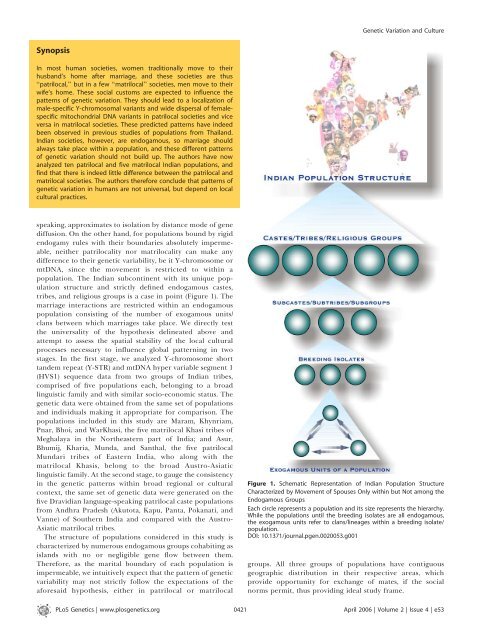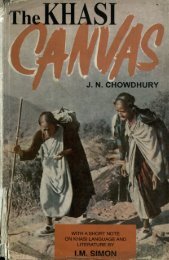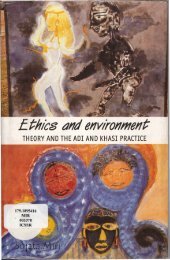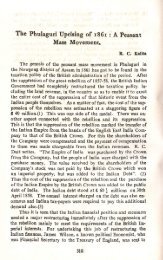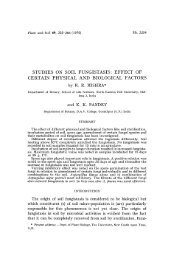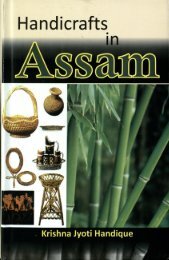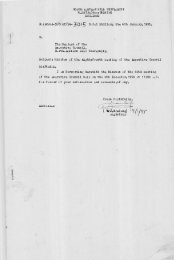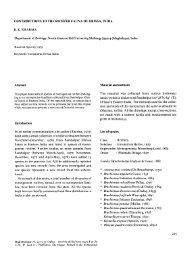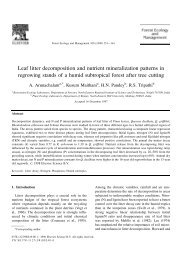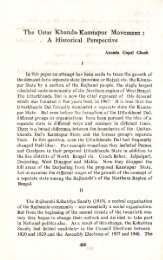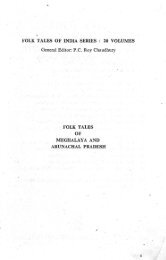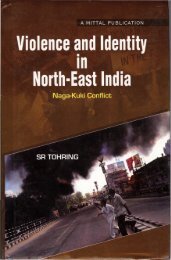ncbi - DSpace@NEHU: Home - North-Eastern Hill University, Shillong
ncbi - DSpace@NEHU: Home - North-Eastern Hill University, Shillong
ncbi - DSpace@NEHU: Home - North-Eastern Hill University, Shillong
Create successful ePaper yourself
Turn your PDF publications into a flip-book with our unique Google optimized e-Paper software.
Synopsis<br />
In most human societies, women traditionally move to their<br />
husband’s home after marriage, and these societies are thus<br />
‘‘patrilocal,’’ but in a few ‘‘matrilocal’’ societies, men move to their<br />
wife’s home. These social customs are expected to influence the<br />
patterns of genetic variation. They should lead to a localization of<br />
male-specific Y-chromosomal variants and wide dispersal of femalespecific<br />
mitochondrial DNA variants in patrilocal societies and vice<br />
versa in matrilocal societies. These predicted patterns have indeed<br />
been observed in previous studies of populations from Thailand.<br />
Indian societies, however, are endogamous, so marriage should<br />
always take place within a population, and these different patterns<br />
of genetic variation should not build up. The authors have now<br />
analyzed ten patrilocal and five matrilocal Indian populations, and<br />
find that there is indeed little difference between the patrilocal and<br />
matrilocal societies. The authors therefore conclude that patterns of<br />
genetic variation in humans are not universal, but depend on local<br />
cultural practices.<br />
speaking, approximates to isolation by distance mode of gene<br />
diffusion. On the other hand, for populations bound by rigid<br />
endogamy rules with their boundaries absolutely impermeable,<br />
neither patrilocality nor matrilocality can make any<br />
difference to their genetic variability, be it Y-chromosome or<br />
mtDNA, since the movement is restricted to within a<br />
population. The Indian subcontinent with its unique population<br />
structure and strictly defined endogamous castes,<br />
tribes, and religious groups is a case in point (Figure 1). The<br />
marriage interactions are restricted within an endogamous<br />
population consisting of the number of exogamous units/<br />
clans between which marriages take place. We directly test<br />
the universality of the hypothesis delineated above and<br />
attempt to assess the spatial stability of the local cultural<br />
processes necessary to influence global patterning in two<br />
stages. In the first stage, we analyzed Y-chromosome short<br />
tandem repeat (Y-STR) and mtDNA hyper variable segment 1<br />
(HVS1) sequence data from two groups of Indian tribes,<br />
comprised of five populations each, belonging to a broad<br />
linguistic family and with similar socio-economic status. The<br />
genetic data were obtained from the same set of populations<br />
and individuals making it appropriate for comparison. The<br />
populations included in this study are Maram, Khynriam,<br />
Pnar, Bhoi, and WarKhasi, the five matrilocal Khasi tribes of<br />
Meghalaya in the <strong>North</strong>eastern part of India; and Asur,<br />
Bhumij, Kharia, Munda, and Santhal, the five patrilocal<br />
Mundari tribes of <strong>Eastern</strong> India, who along with the<br />
matrilocal Khasis, belong to the broad Austro-Asiatic<br />
linguistic family. At the second stage, to gauge the consistency<br />
in the genetic patterns within broad regional or cultural<br />
context, the same set of genetic data were generated on the<br />
five Dravidian language-speaking patrilocal caste populations<br />
from Andhra Pradesh (Akutota, Kapu, Panta, Pokanati, and<br />
Vanne) of Southern India and compared with the Austro-<br />
Asiatic matrilocal tribes.<br />
The structure of populations considered in this study is<br />
characterized by numerous endogamous groups cohabiting as<br />
islands with no or negligible gene flow between them.<br />
Therefore, as the marital boundary of each population is<br />
impermeable, we intuitively expect that the pattern of genetic<br />
variability may not strictly follow the expectations of the<br />
aforesaid hypothesis, either in patrilocal or matrilocal<br />
Genetic Variation and Culture<br />
Figure 1. Schematic Representation of Indian Population Structure<br />
Characterized by Movement of Spouses Only within but Not among the<br />
Endogamous Groups<br />
Each circle represents a population and its size represents the hierarchy.<br />
While the populations until the breeding isolates are all endogamous,<br />
the exogamous units refer to clans/lineages within a breeding isolate/<br />
population.<br />
DOI: 10.1371/journal.pgen.0020053.g001<br />
groups. All three groups of populations have contiguous<br />
geographic distribution in their respective areas, which<br />
provide opportunity for exchange of mates, if the social<br />
norms permit, thus providing ideal study frame.<br />
PLoS Genetics | www.plosgenetics.org 0421<br />
April 2006 | Volume 2 | Issue 4 | e53


